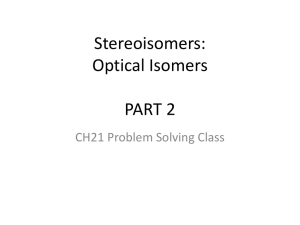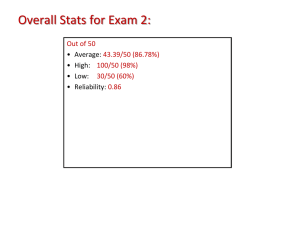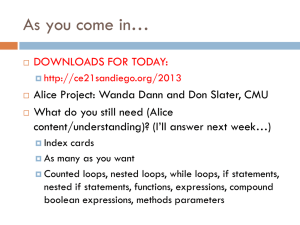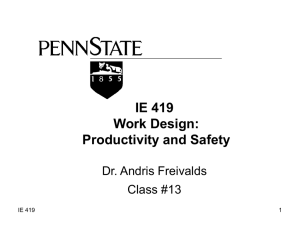I agree
advertisement
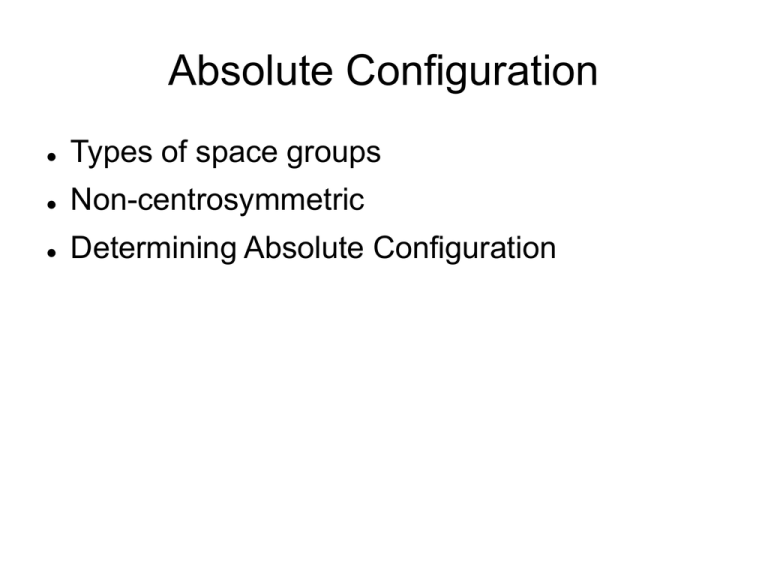
Absolute Configuration Types of space groups Non-centrosymmetric Determining Absolute Configuration Centric Space Groups • • • Any space group that has the inversion symmetry operation In this case the phase problem reduces to a determination of the sign of the amplitude. Do not need to worry about cell handedness or absolute configuration. Non-centrosymmetric Space Groups • • • Come in two forms. Type one is a cell that does not contain an inversion center but does contain a mirror (glide plane) or improper rotation axes. This class of cells can NOT contain enantiomorphically pure compoumds The other type does not contain the above symmetry elements and can crystallize optically pure materials—Polar Space Groups How can a cell be enantiomorphic if the contents are racemic? For non-polar accentric cells the contents are racemic yet the unit cell is enanitomorphic. The arrangement of molecules in the unit cell creates the optical activity. Is there a chemical analogy? Consider Co(en)33+ Obviously Co3+ nor ethylenediamine is optically active Co(en)3 Yet the ion is optically active Note there is not a single enantiomorphic atom in the structure. The overall arrangement creates the optical activity. Anomalous Scattering(AS) • • • • • AS arises from absorbed then emitted photons. These photons are out of phase with the normally scattered photons. AS is important in both centric and accentric space groups. The components of AS are given by f' and f” where f' is the real and f” the imaginary component. The values of f' and f” are functions of the wavelength used but are independent of the scattering angle. What does imaginary mean? How does AO effect centric scattering How does it effect accentric space groups? A problem • Since we cannot tell x,y,z from -x,-y,-z then we are not sure which is really hkl and which -h-k-l (These are the Friedel pairs) • This means we do not know if we are adding or subtracting the AS imaginary component from the real component. • If the handedness is correct and the enantiomorph correct then the addition sign will be correct. If one of these is incorrect then the result will be subtraction. • If the absolute configuration is correct than the correct Friedel pair will have the correct intensity difference. • If incorrect than the more intense will actually be less intense and vice versa. • This is the origin for using AO to determine absolute confguration. • Discovered by the Dutch crystallographer Johannes Bijvoet. How big is this effect. Observations • • • • Because the normal scattering falls off with the diffraction angle but the anomalous scattering does not the AS contribution will be greatest for high angle reflections. However, these are the weakest reflections with the largest errors. Means the differences because of AS may be less than the error. In general it is impossible to determine the absolute configuration for compounds containing only light atoms (<Na) using Mo radiation The heavy atom can be anywhere in the cell. Changing Absolute Configuration • • • Change all atomic positions so xyz is now -x-y-z Some polar space groups come in pairs – – • P31 P32 P41 P43 P61 P65 In this case besides the atomic positions, the space group must be changed to the other of the pair For space groups with d glides it is somewhat more complex. How to determine the absolute configuration • • • It must be noted that the configuration is either all correct or all incorrect everywhere. Therefore if the configuration of one atom is known it can be used to set all the other atoms. Examples – – – Steroids Tartrates using natural tartaric acid Part of a molecule unchanged in synthesis. Bijvoet Method • • • • • Collect all data and Friedel pairs. Find the pairs that have the biggest intensity difference between hkl and -h-k-l See how these agree with Fcalc Change the absolute structure and see if the agreement improves or gets worse. Problem: need twice as much data as needed to solve the structure R-factor method • • • • • • Refine one absolute structure to completion Invert the structure and refine this to completion. Compare the R-factors. The lowest one is correct. However, need to do a statistical analysis using Hamilton's T test to determine if this is statistically real. Advantage—do not need Friedel pairs Disadvantage – usually fails unless there is a heavy atom present. Refinement Parameters • • • Rogers suggested refining the sign of the anomalous terms. +1 means correct -1 means incorrect. While this works the parameter is very slow to converge and requires many cycles of refinement before it settles down. Howard Flack suggested use a parameter to refine both enantiomers at once. The one being refined had an occupancy of (1-x) while the other was x. Flack Parameter If the Flack Parameter (x) refines to zero then the enantiomer is correct, while 1 is incorrect. The Flack Parameter can take on values outside of 0 to 1. These are generally meaningless and suggest the anomalous scattering is too weak to use. The s.u. in the Flack Parameter is important. 0.2(1) suggests correct. 0.2 (6) suggests nothing. Flack Parameter Advantages Do not need Friedel pairs to calculate. Provides a quantitative indicator of the absolute configuration. Disadvantages The Flack Parameter tends to correlate with other parameters when there is not much Friedel pair data. It is not Chemist friendly The Hooft Approach Rob Hooft and Ton Spek worked on a new approach. They assumed that most of the Friedel data would be collected which is true for modern area detectors. Their method is in PLATON as the Bijvoet calculation and appears in our table ent.txt Good Output Absolute Structure Analysis Flack Parameter 0.050 +/- 0.060 Hooft Parameter 0.024 +/- 0.037 Friedel Coverage 99.6% Assuming No Racemic Twinning is Present Probability Absolute Structure is Correct 1.000 Probabilities Allowing for Racemic Twinning Probability Absolute Structure is Correct 1.000 Probability Absolute Structure is Incorrect 0.0E+00 Probability Crystal is a Racemic Twin 0.2E-35 Hooft,R.W.W.,Straver,L.H.,and Spek, A.L.(2008). J. Appl. Cryst.,41,96-103. Undetermined Output Absolute Structure Analysis Flack Parameter 0.400 +/- 1.200 Hooft Parameter 0.417 +/- 0.634 Friedel Coverage 98.6% Assuming No Racemic Twinning is Present Probability Absolute Structure is Correct 0.551 Probabilities Allowing for Racemic Twinning Probability Absolute Structure is Correct 0.329 Probability Absolute Structure is Incorrect 0.267 Probability Crystal is a Racemic Twin 0.404 The absoloute structure could be better determined by collecting another data set using copper radiation! Hooft,R.W.W.,Straver,L.H.,and Spek, A.L.(2008). J. Appl. Cryst.,41,96-103. Borderline Absolute Structure Analysis Flack Parameter 0.210 +/- 0.180 Hooft Parameter 0.216 +/- 0.070 Friedel Coverage 94.6 Assuming No Racemic Twinning is Present Probability Absolute Structure is Correct n/a Probabilities Allowing for Racemic Twinning Probability Absolute Structure is Correct 0.970 Probability Absolute Structure is Incorrect 0.8E-25 Probability Crystal is a Racemic Twin 0.030 Borderline Absolute Structure Analysis Flack Parameter 0.210 +/- 0.180 Hooft Parameter 0.216 +/- 0.070 Friedel Coverage 94.6 Assuming No Racemic Twinning is Present Probability Absolute Structure is Correct n/a Probabilities Allowing for Racemic Twinning Probability Absolute Structure is Correct 0.970 Probability Absolute Structure is Incorrect 0.8E-25 Probability Crystal is a Racemic Twin 0.030 Hooft Method Advantages Very Quantitative Chemist Friendly Lower errors on the Hooft y Parameter than the Flack Parameter Disadvantages Requires Friedel pair data Is very sensitive to how data is collected.
